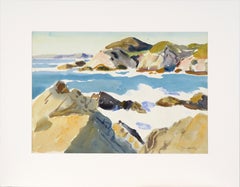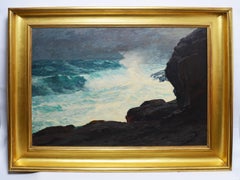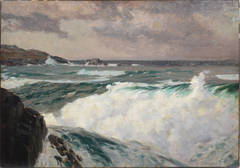Paul Dougherty Art
American, 1877-1947
Paul Dougherty was an American marine painter known for his American Impressionist paintings of the coasts of Maine and Cornwall in the years after the turn of the 20th century. His work has been described as bold and masculine. Some of his recognized work includes paintings of breakers crashing against rocky coasts and mountain landscapes. He also liked painting still life, creating prints and sculpting.
to
2
2
2
2
Overall Height
to
Overall Width
to
2
2
2
2
2
1
1
2
2
6,827
3,114
2,517
1,217
2
2
2
Artist: Paul Dougherty
Big Sur Coast Landscape in Watercolor on Paper
By Paul Dougherty
Located in Soquel, CA
Big Sur Coast Landscape in Watercolor on Paper
Serene coastal landscape by notable artist Paul Dougherty (American, 1877-1947). The viewer looks out ov...
Category
Early 20th Century American Impressionist Paul Dougherty Art
Materials
Paper, Watercolor
Rocky California Seascape in Watercolor on Paper
By Paul Dougherty
Located in Soquel, CA
Rocky California Seascape in Watercolor on Paper
Dramatic coastal landscape by notable artist Paul Dougherty (American, 1877-1947). Waves are churning ...
Category
Early 20th Century American Impressionist Paul Dougherty Art
Materials
Paper, Watercolor
Related Items
"Train Station, " Max Kuehne, Industrial City Scene, American Impressionism
By Max Kuehne
Located in New York, NY
Max Kuehne (1880 - 1968)
Train Station, circa 1910
Watercolor on paper
8 1/4 x 10 1/4 inches
Signed lower right
Provenance:
Private Collection, Illinois
Max Kuehne was born in Halle, Germany on November 7, 1880. During his adolescence the family immigrated to America and settled in Flushing, New York. As a young man, Max was active in rowing events, bicycle racing, swimming and sailing. After experimenting with various occupations, Kuehne decided to study art, which led him to William Merritt Chase's famous school in New York; he was trained by Chase himself, then by Kenneth Hayes Miller. Chase was at the peak of his career, and his portraits were especially in demand. Kuehne would have profited from Chase's invaluable lessons in technique, as well as his inspirational personality. Miller, only four years older than Kuehne, was another of the many artists to benefit from Chase's teachings. Even though Miller still would have been under the spell of Chase upon Kuehne's arrival, he was already experimenting with an aestheticism that went beyond Chase's realism and virtuosity of the brush. Later Miller developed a style dependent upon volumetric figures that recall Italian Renaissance prototypes.
Kuehne moved from Miller to Robert Henri in 1909. Rockwell Kent, who also studied under Chase, Miller, and Henri, expressed what he felt were their respective contributions: "As Chase had taught us to use our eyes, and Henri to enlist our hearts, Miller called on us to use our heads." (Rockwell Kent, It's Me O Lord: The Autobiography of Rockwell Kent. New York: Dodd, Mead and Co., 1955, p. 83). Henri prompted Kuehne to search out the unvarnished realities of urban living; a notable portion of Henri's stylistic formula was incorporated into his work.
Having received such a thorough foundation in art, Kuehne spent a year in Europe's major art museums to study techniques of the old masters. His son Richard named Ernest Lawson as one of Max Kuehne's European traveling companions. In 1911 Kuehne moved to New York where he maintained a studio and painted everyday scenes around him, using the rather Manet-like, dark palette of Henri.
A trip to Gloucester during the following summer engendered a brighter palette. In the words of Gallatin (1924, p. 60), during that summer Kuehne "executed some of his most successful pictures, paintings full of sunlight . . . revealing the fact that he was becoming a colorist of considerable distinction." Kuehne was away in England the year of the Armory Show (1913), where he worked on powerful, painterly seascapes on the rocky shores of Cornwall. Possibly inspired by Henri - who had discovered Madrid in 1900 then took classes there in 1906, 1908 and 1912 - Kuehne visited Spain in 1914; in all, he would spend three years there, maintaining a studio in Granada. He developed his own impressionism and a greater simplicity while in Spain, under the influence of the brilliant Mediterranean light. George Bellows convinced Kuehne to spend the summer of 1919 in Rockport, Maine (near Camden). The influence of Bellows was more than casual; he would have intensified Kuehne's commitment to paint life "in the raw" around him.
After another brief trip to Spain in 1920, Kuehne went to the other Rockport (Cape Ann, Massachusetts) where he was accepted as a member of the vigorous art colony, spearheaded by Aldro T. Hibbard. Rockport's picturesque ambiance fulfilled the needs of an artist-sailor: as a writer in the Gloucester Daily Times explained, "Max Kuehne came to Rockport to paint, but he stayed to sail." The 1920s was a boom decade for Cape Ann, as it was for the rest of the nation. Kuehne's studio in Rockport was formerly occupied by Jonas Lie.
Kuehne spent the summer of 1923 in Paris, where in July, André Breton started a brawl as the curtain went up on a play by his rival Tristan Tzara; the event signified the demise of the Dada movement. Kuehne could not relate to this avant-garde art but was apparently influenced by more traditional painters — the Fauves, Nabis, and painters such as Bonnard. Gallatin perceived a looser handling and more brilliant color in the pictures Kuehne brought back to the States in the fall. In 1926, Kuehne won the First Honorable Mention at the Carnegie Institute, and he re-exhibited there, for example, in 1937 (Before the Wind). Besides painting, Kuehne did sculpture, decorative screens, and furniture work with carved and gilded molding. In addition, he designed and carved his own frames, and John Taylor Adams encouraged Kuehne to execute etchings. Through his talents in all these media he was able to survive the Depression, and during the 1940s and 1950s these activities almost eclipsed his easel painting. In later years, Kuehne's landscapes and still-lifes show the influence of Cézanne and Bonnard, and his style changed radically.
Max Kuehne died in 1968. He exhibited his work at the National Academy of Design, the Art Institute of Chicago, the Carnegie Institute in Pittsburgh, the Memorial Art Gallery of the University of Rochester, and in various New York City galleries. Kuehne's works are in the following public collections: the Detroit Institute of Arts (Marine Headland), the Whitney Museum (Diamond Hill...
Category
1910s American Impressionist Paul Dougherty Art
Materials
Paper, Watercolor
"Monhegan Island, Maine, " Edward Dufner, American Impressionism Landscape View
By Edward Dufner
Located in New York, NY
Edward Dufner (1872 - 1957)
Monhegan Island, Maine
Watercolor on paper
Sight 16 x 20 inches
Signed lower right
With a long-time career as an art teacher and painter of both 'light' and 'dark', Edward Dufner was one of the first students of the Buffalo Fine Arts Academy to earn an Albright Scholarship to study painting in New York. In Buffalo, he had exchanged odd job work for drawing lessons from architect Charles Sumner. He also earned money as an illustrator of a German-language newspaper, and in 1890 took lessons from George Bridgman at the Buffalo Fine Arts Academy.
In 1893, using his scholarship, Dufner moved to Manhattan and enrolled at the Art Students League where he studied with Henry Siddons Mowbray, figure painter and muralist. He also did illustration work for Life, Harper's and Scribner's magazines.
Five years later, in 1898, Dufner went to Paris where he studied at the Academy Julian with Jean-Paul Laurens and privately with James McNeill Whistler. Verification of this relationship, which has been debated by art scholars, comes from researcher Nancy Turk who located at the Smithsonian Institution two 1927 interviews given by Dufner. Turk wrote that Dufner "talks in detail about Whistler, about how he prepared his canvasas and about numerous pieces he painted. . . A great read, the interview puts to bed" the ongoing confusion about whether or not he studied with Whistler.
During his time in France, Dufner summered in the south at Le Pouleu with artists Richard Emil Miller...
Category
Early 20th Century American Impressionist Paul Dougherty Art
Materials
Paper, Watercolor
Landscape View With Cows Drinking Water by American Artist Hugo Anton Fisher
Located in Stockholm, SE
American artist Hugo Anton Fisher was primarily known for painting landscapes in watercolor. He was born into a family of artists in Kladno, Bohemia....
Category
Late 19th Century American Impressionist Paul Dougherty Art
Materials
Paper, Watercolor
Free Shipping
H 11.42 in W 17.52 in
"River Landscape" Julian Alden Weir, American Impressionist, Connecticut Scene
By Julian Alden Weir
Located in New York, NY
Julian Alden Weir
River Landscape
Signed lower left
Watercolor on paper
9 x 11 1/2 inches
Provenance:
Kraushaar Galleries, New York
Sotheby's Parke Bernet, New York, 1965, Lot 27
E....
Category
Late 19th Century American Impressionist Paul Dougherty Art
Materials
Watercolor, Paper
'Moss Beach, Monterey, California', Pacific Coastal Landscape, ASL NYC, Benezit
By Elmer Wachtel
Located in Santa Cruz, CA
An early-20th-century, landscape showing a view of the coastline at Moss Beach in Monterey County with slate-blue skies overhead and a view towards a stand ...
Category
Early 1900s American Impressionist Paul Dougherty Art
Materials
Gouache, Watercolor, Paper
"Old Adobe Village, New Mexico" Alice Schille, Taos Pueblo, Female Impressionist
By Alice Schille
Located in New York, NY
Alice Schille
Old Adobe Village, New Mexico
Signed lower right
Watercolor on paper
5 x 6 inches
Provenance:
Estate of the artist
Keny and Johnson Gallery, Columbus, Ohio
Santa Fe East Galleries, Santa Fe, New Mexico
Private Collection, California
A painter in watercolor and oil, Alice Schille was a prolific artist using modernist styles of Post-Impressionism, Pointillism and Fauvism. Her subjects included portraits of women and children, landscapes with and without figures, a series of scenes of New York City. New Mexico, and Gloucester, Massachusetts. Her paintings also reflected her widespread international travels in Europe, North Africa, Russia, the Middle East, Mexico, and Guatemala.
Although personally very shy, Schille possessed unusual courage and strength of will, which was reflected in both her independent lifestyle and in her work, as she continually worked to master new modes of painting throughout her career. A German critic once referred to Schille as "this daredevil disciple of art who is interested in anything and afraid of nothing."
Alice Schille was born in Columbus, Ohio to a family supported by her father's success in manufacturing. She was raised in Columbus, and by the time she was age six, she determined to be an artist. She graduated at the top of her class from Central High School in 1887, studied from 1891 to 1893 at the Columbus Art School, and returned there as a teacher from 1902 to 1948.
Going to New York City as a young woman, she enrolled in the Art Students League from 1897 to 1899 and then the New York School of Art with William Merritt Chase and Kenyon Cox. (Some years later, she attended Chase's Shinnecock Summer School on Long Island). From 1903 to 1904, Alice Schille was in Paris at the Academie Colarosi, and also studied privately with Raphael Collin, Rene Prinet, Gustave Courtois and Chase, who was then in Europe.
In 1904, five of her paintings were accepted for exhibition at Societe Nationale des Beaux Arts, and from that time on her work was included regularly in important American annual exhibitions including the Pennsylvania Academy, the Corcoran Gallery, American Watercolor Society, Boston Art Club, and the 1987 inaugural exhibition of the National Museum of Women in the Arts in Washington DC.
Between 1905 and 1914, Alice Schille painted in Europe, and during the summers of 1916 to 1918, worked in New York and Gloucester. In 1919, she was in New Mexico. On this trip, her first to the Southwest, she spent a summer in Taos and Santa Fe and painted scenes including the Taos Pueblo, Canyon Road and local Hispanic and Indian figures. Reportedly the Ranchos de Taos Church was one of her favorite subjects. Many of these New Mexico paintings were hung at annual exhibitions of the Philadelphia Water Color Club.
Between 1920 and 1940, she traveled frequently in the summers, returning to New Mexico and going to Central America and Africa. In 1922, she began her first series of North-African watercolors...
Category
1920s American Impressionist Paul Dougherty Art
Materials
Paper, Watercolor
Searching the Waters
By Lu Haskew
Located in Loveland, CO
Searching the Waters by Lu Haskew
Pastel 18x22" image size, 26x30" framed
Figurative Portrait of young children on a dock looking into the water.
ABOUT THE ARTIST: Lu Haskew 1921...
Category
1990s American Impressionist Paul Dougherty Art
Materials
Watercolor
"Cloudy Dock Scene", working peir with fishermen, boats, and architecture
By John Cuthbert Hare
Located in Rockport, MA
John Cuthbert Hare was an accomplished New England painter born in Brooklyn, New York. He began his artistic journey by studying commercial art at the Pratt Institute in New York Cit...
Category
Mid-20th Century American Impressionist Paul Dougherty Art
Materials
Paper, Watercolor
Pink Umbrella. Green Chair
By Mary Robertson
Located in Burlingame, CA
Serene river scene watercolor from important Bay Area figurative contemporary artists Mary Robertson, who is associated with the Bay Area Figurative School, founded by Elmer Bischoff...
Category
2010s American Impressionist Paul Dougherty Art
Materials
Paper, Watercolor
Canal at Indian Mound Road
By Ben Fenske
Located in Sag Harbor, NY
Painted during the 2015 Winter Equestrian Festival in Wellington, Florida. A black and white depiction of a canal, is barely recognizable, due to Fenske's wild brushstrokes and lack...
Category
21st Century and Contemporary American Impressionist Paul Dougherty Art
Materials
Gouache, Paper
Canyon Country
By Lu Haskew
Located in Loveland, CO
Canyon Country by Lu Haskew
Pastel 16x20" image size
Landscape view of the Grand Canyon
ABOUT THE ARTIST: Lu Haskew 1921-2009
"Life is good to me. Being able to go to my studio five days weekly and paint for several hours, living in a supportive community, having family and friends who encourage me--all have contributed to helping me become an artist. Being fortunate to study with some of the artists I admire has kept me painting from the garden, people and my favorite things. With the support of galleries, teaching and doing demos, how could I do anything else? My goal is to try to be the best I can be by always being a student, looking for new ideas and stretching my horizons."
Upon retirement from a 33-year teaching career, Lu rented a studio in Loveland and began concentrating on
her oil and watercolor painting. Learning from artists she had followed and admired throughout the years
her painting became a full time career. Since 1992, she has studied with renowned painters Richard
Schmid, Clyde Aspevig, Joyce Pike, and others at the Scottsdale Art...
Category
1990s American Impressionist Paul Dougherty Art
Materials
Watercolor
Mother and Children watercolor painting by John E. Costigan
By John Costigan
Located in Hudson, NY
Painting measures 22" x 28" and framed 26" x 32" x 2"
Hand-signed "J.E. Costigan NA 1952" lower left.
About this artist: John Costigan was a self-taught painter distinguished by h...
Category
Mid-20th Century American Impressionist Paul Dougherty Art
Materials
Paper, Watercolor
Previously Available Items
Crashing Surf by Paul Dougherty
By Paul Dougherty
Located in Buffalo, NY
Large seascape oil painting with crashing surf by Paul Dougherty (1877 - 1947). Oil on canvas, circa 1905. Signed lower right, "Paul Do...
Category
Early 1900s Impressionist Paul Dougherty Art
Materials
Canvas, Oil
Crashing Surf
By Paul Dougherty
Located in Buffalo, NY
A large oil on canvas by Paul Dougherty. Finely painted with thick impasto and great depth. Excellent condition. A couple spot touch ups. Signed low...
Category
Early 1900s American Impressionist Paul Dougherty Art
Materials
Canvas, Oil
Paul Dougherty art for sale on 1stDibs.
Find a wide variety of authentic Paul Dougherty art available for sale on 1stDibs. You can also browse by medium to find art by Paul Dougherty in paint, paper, watercolor and more. Much of the original work by this artist or collective was created during the 20th century and is mostly associated with the Impressionist style. Not every interior allows for large Paul Dougherty art, so small editions measuring 27 inches across are available. Customers who are interested in this artist might also find the work of James March Phillips, Greta Allen, and Laurence Sisson. Paul Dougherty art prices can differ depending upon medium, time period and other attributes. On 1stDibs, the price for these items starts at $1,480 and tops out at $1,480, while the average work can sell for $1,480.





